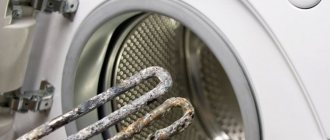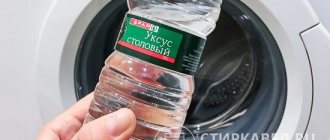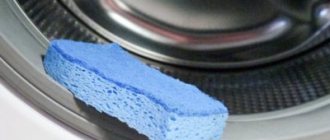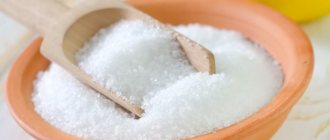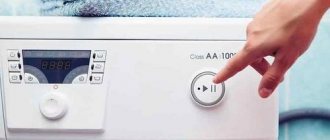Do you want to extend the trouble-free operation of your washing machine by cleaning its main elements? Agree, it’s great when the washing machine works like a clock: load the laundry, pour in the powder, press start. To do this, it is worth remembering the most important thing: any equipment needs care.
But the range of detergents is very rich and you don’t know which of them can cope with the task? We will help you figure out how and how to clean your washing machine from a variety of contaminants - from scale to banal dirt and the ubiquitous fungus.
The article discusses effective methods of cleaning the heating element with an overview of the most effective means. To avoid breakdowns of expensive appliances, floods and other consequences of oversight, we offer step-by-step instructions on how to perform comprehensive cleaning of all important components and elements of the washing machine.
We have selected photos depicting important stages of the process, as well as useful videos demonstrating the prevention and maintenance of the unit on our own.
Causes of unpleasant odor
If you are reading this article, then the topic is relevant to you, which means that one fine day you suddenly discovered that your washing machine is emitting, to put it mildly, an unpleasant odor. At best, it will simply be a damp smell, which is often found in basements. In a more advanced version, it will be a pronounced sewer smell. And then bewilderment sets in, especially if your machine is completely new or you did everything as always. The usual smell of freshness can be replaced by a foreign aroma for several reasons :
- The most common and most basic mistake is closing the hatch immediately after removing the washed items. This is strictly forbidden. The moisture in the drum dries out within a few hours. Only after this time has passed can the lid be closed to prevent it from sagging in the future. Otherwise, you will create more than favorable conditions for the proliferation of various microorganisms or mold - the drum will be warm and damp. Believe me, when in a couple of days you open the hatch, you will simply be horrified, because your device has simply “choked.” And if you wash things without first eliminating the smell, they will also acquire a characteristic aroma;
- Even if some housewives are not lazy and still wipe the drum dry after washing, not all of them pay attention to such a detail as the elastic band along the contour of the hatch . It has a rather complex shape, on which the tightness depends. There are several layers, between which, in addition to water and detergent residues, threads, lint, hair and other objects can remain. In conditions of high humidity, this material is an excellent place for mold to form, which will eventually emit a strange odor. Sometimes it is not even immediately possible to understand why an extraneous odor is present at all if the drum is dry and clean. Therefore, it is better to leave the drum to dry naturally, but carefully wipe the elastic band with a dry soft cloth;
- Another mistake that occurs almost everywhere is storing items to be washed in a drum. And if you close the door at the same time... Remember, dirty things will in any case have a characteristic odor, which will very easily and persistently attach itself inside the drum. Especially if you also block the air supply to things. It’s not for nothing that laundry baskets were invented. They are even produced in different sizes, shapes, colors and designs. Everything so that you can harmoniously fit this attribute into the interior of the bathroom and use it for its intended purpose. All baskets have holes in the walls, lid and bottom, thereby providing ventilation;
- Another reason could be improper installation of the machine . Please note, not connection, but installation. If the appliance is tilted, this may prevent the water from draining completely. As a result, in the corner where there is the smallest slope angle, a small amount of water will remain and stagnate. When exactly musty water makes itself known is only a matter of time;
- If the machine is quite old, the cause of the unpleasant odor may be a clogged drain hose. If a smell appears, it means that so much debris has already accumulated on its walls, on which soap scum, salt, etc. have settled, that it will be much easier and more expedient to replace it than to clean it;
- If you overuse laundry detergent and various conditioners, this can also contribute to the appearance of characteristic odors. Excess product, which simply did not have time to dissolve during washing, sticks to the walls of the machine, the tray for pouring powder, and after some time begins to “smell” actively. And not at all a pleasant aroma of fragrances, as you would like, but rather something rotten. In this case, the rule “more is better” does not work at all. A lack of washing powder will simply result in things not being washed. Therefore, it is best to purchase a measuring spoon or cup and pour in exactly as much powder as the manufacturer recommends in the instructions on the package;
- You should also pay attention to the quality of the products used in washing. Frankly cheap powders may not dissolve well in water. The result will be similar to the point above. Therefore, whenever possible, purchase quality products. In addition, their consumption will be much less, and the washing result will be of higher quality;
- If the tray for loading powder and conditioner is dirty, this can also cause the formation of various odors;
- If the tray is very dirty, then contamination of the channel that is responsible for supplying the detergent is automatically inevitable. Because of this, mold may form, which will smell;
- Another problem area is the drain filter . It is designed to hold various large objects, for example, buttons, pennies, so that they do not clog the sewer. Remaining on the filter, such things gradually begin to become overgrown with soap deposits, to which all sorts of lint strings stick, silt up and begin to stink. It is quite easy to understand whether this is the reason. If the filter is clogged, the water will drain very slowly or stop draining at all;
- If the smell is similar to something rotten or rotten, it means that an impressive layer of dirt has formed on the heating element. If the heating element has scale layer, undissolved detergent particles settle on it very quickly, hair, threads, pet lint or woolen items stick to them. Such a “cocktail” especially makes itself felt if the most familiar washing mode for you is at a temperature of 30-40°C;
- Problems with the sewerage system itself cannot be ruled out. But then, in the event of any accidents or breakdowns, an unpleasant odor will come from both the sink and the bathtub. And if the aroma comes only from the washing machine, perhaps it is not connected correctly - there is no air or water barrier.
As you can see, there are a lot of reasons. Often they are present in a complex. Therefore, the very first step towards identifying the source of the unpleasant odor will be a complete inspection of all elements of the washing machine.
Useful tips
To ensure that your washing machine serves you for a long time and without interruption, use the following tips:
- When washing, use only as much detergent, softener and bleach as you need to wash a specific number of items. Excess laundry detergent will not help make clothes cleaner; it will simply settle inside the unit and lead to breakdowns in the future.
- Before washing, be sure to check the pockets of your items. Take out everything unnecessary so as not to clog the drain filter.
- Do not delay washing if you have already placed a large amount of dirty laundry in the drum.
- Ventilate the drum after each use.
IMPORTANT! Remember to immediately remove items from the drum immediately after washing and send them to dry.
Why does the machine smell like burning?
Sometimes a washing machine can smell not only of dampness, mustiness or rot, but also of burning. This can happen in several cases:
- If the washing machine has just been purchased. Usually, when you first start it, a slight smell, reminiscent of a burning smell, is normal. But it is worth emphasizing that it is light and short-lived. It may appear when plastic parts are heated. And after the second or third turn on it should disappear completely;
- An old machine may also smell like burning, but this is only normal if you replaced the powder with a new one, and it turned out to be not of very high quality, or if shavings of laundry soap were added directly to the drum during washing. This is especially often done by mothers of newborns, arguing that it is safer for the child. There is no point in arguing with this. The smell appears if soap particles get on the heating element and stick to it. In this case, it will emit burning not just during washing, but during the subsequent start-up while heating the soap residues.
If none of the above options are typical for you, or the burning smell does not disappear after running the machine at maximum temperature without idling, be sure to call a technician , because most likely we are talking about the breakdown and melting of some contacts, which can lead to a short circuit.
Prevention of plaque
It is almost impossible to completely prevent scale formation in a washing machine. Preventive measures include the following:
- Install filters at the entrance to the house (apartment), which would purify the water from mechanical and other pollutants, and also soften its composition. One of the filtration options is a magnetic filter that can change the crystalline structure of water.
- Periodic cleaning of the washing machine from scale using one of the methods.
- Refusal to wash old items, as well as those from which lint and threads are separated. When washing, such particles quickly stick to the heating element and accelerate the formation of scale.
- Refusal to machine wash heavily soiled items - in solvents, building mixtures, etc. These substances can also stick to the heating element and contribute to the fouling of the heating element with lime.
- Frequent washing at high temperatures with a long processing cycle also contributes to the formation of scale.
How is scale formed and why is it dangerous?
Another inevitable problem when operating any device that comes into contact with water is the formation of scale. If you have a boiler with an open or “wet” heating element, then you probably know this phenomenon.
Scale is hard deposits that form on the surfaces of elements that come into direct contact with water and heat it. reasons for the formation of such plaque:
- The most basic is the very poor quality of water, which contains many different impurities and components. In some regions or areas the water may be softer, in others it may be too hard. The water contains magnesium and calcium salts, which are the most harmful to the heating element and the washing machine tank. When water is heated, the salts of these minerals precipitate and form solid deposits;
- In addition to impurities in the water itself, various chemical additives in washing powders also have a detrimental effect;
- Also, scale forms very quickly when the machine is regularly used in the “intensive wash” mode.
to get rid of scale . And it is best to use them in combination. But first of all, you need to evaluate how advisable it is to do this right now. To do this, you need to try to consider the state of the heating element through the holes of the drum. To do this, you need to shine light into the holes and rotate the drum. You will understand in the process how best to do this quickly. If characteristic deposits are visible on the surface, perform two types of cleaning in sequence:
- Mechanical. It is a very effective way. But to do this, you will need to thoroughly study the structure of your device and be able to disassemble it without dire consequences. After you get to the heating element and more clearly appreciate the full scale of the tragedy, you will need to remove the hard coating. It is highly not recommended to use knives, screwdrivers, files and other improvised tools for these purposes that can leave scratches on the surface. It is better to use a sponge with a hard layer, fine-grained sandpaper;
- After this, to remove any remaining scale, soak the heating element in a solution of vinegar or citric acid for several hours, then thoroughly brush with a toothbrush and rinse with clean water. Also, with the help of these two products, you can clean the machine without disassembling it, but more on that a little later. I would also like to clarify exactly what is dangerous about excessive scale accumulation on the heating element:
- The level of heat transfer from the tubes, which are called heating elements, is noticeably reduced due to the build-up of plaque on their surface. This causes the water to heat up more slowly;
- As a result, to achieve the set temperature, the machine needs to work much longer, which naturally entails increased energy consumption;
- The large load that falls on the heating element under such operating conditions will lead to its rapid breakdown and the need for replacement;
- And as we have already found out, scale formation can cause an unpleasant odor.
- An excellent method of preventing scale formation is to install a magnetic filter. This small device is attached to the water supply hose and creates a constant magnetic field. When the machine is filled with water, passing through the formed field, it changes its structure. As a result, impurities are destroyed and do not settle on internal surfaces. The cost of such a device is quite high, however, its service life reaches 50 years, which fully justifies the costs.
We remove scale from the heating element and internal elements
One of the most serious accidents that can easily happen if you do not properly care for your washing machine is the failure of a tubular electric heater.
A failed heating element can block the operation of the machine both at the initial stage (the selected mode simply cannot be started) and stop the washing process in full swing
Since the heating element is in contact with running water, scale forms on it after each wash - deposits of calcium and magnesium salts.
Therefore, if a softening filter is not installed in the drain, it is recommended to add special agents to the powder (for example, Calgon ) and carry out preventive maintenance at least once a month.
Method #1 - improvised materials from stocks
One of the simplest and most effective ways to combat lime deposits is to pour tribasic carboxylic or citric acid into the powder compartment and turn it on at any high temperature setting.
This recipe works simply: when heated, the acid actively corrodes not only light deposits, but also caked limestone, as a result of which it cleans both the heating element and the steel of the drum.
Never combine the cleaning process with washing things - even home remedies like baking soda or vinegar solution (not to mention citric acid) can cause irreparable damage to fabrics
Calculation of the required amount of powder must be done based on the degree of contamination of the machine and its container. On average, for every kilogram of loading there is about 25-30 grams of acid.
If the unit has not been cleaned for a long time, you can take note of the following advice: pour acid into the powder container, run any long washing mode with a temperature of 90°C and above and turn off the power from the network halfway through the process. Leave it overnight and start the machine again in the morning.
Citric acid can be poured directly into the drum, but it’s better to put it in the detergent compartment to clean it at the same time
It is recommended to use this procedure no more than 4 times a year, and after each time you must check the drain hose and drum cuff to remove large particles of loose limestone.
Other home remedies and their uses:
- Table vinegar - pour 1-2 cups of a 9 percent acetic acid solution into the detergent cuvette, select a high-temperature mode with long washing and pre-soaking. To get rid of the specific sour smell, you can then turn on an additional rinse.
- Baking soda and vinegar - to enhance the effect of acid on limescale, a special solution will be useful. It is prepared like this: half a glass of soda is mixed with the same amount of water and placed in a container for powder, and 1 glass of 9% vinegar is poured into the drum. Then the machine starts in any long-term mode at maximum temperature.
- Bleach and other chlorine -containing products are used in the old fashioned way by many housewives for comprehensive cleaning and disinfection of the washing machine.
But in fact, the effectiveness of caustic preparations is very doubtful: they will not save you from scale, but some elements (for example, the rubber drum seal and various sealing gaskets) can cause great damage. And chlorine vapors are harmful to health.
There are also more innovative “recipes” for cleaning a washing machine, for example, pour 5-6 liters of Coca-Cola into the tank and leave for a couple of hours
But we looked at the most reliable, cheap, safe and practice-tested methods for getting rid of scale using improvised means.
Method #2 - special chemicals
The cleaning agent for washing machine elements must be safe for humans, fabrics and all internal surfaces of the device, and also effectively remove lime deposits and other contaminants.
Specialized preparations have an important advantage over “folk” ones - their composition is developed taking into account the design features of the device and does not harm some elements while cleaning others.
To buy the right “chemistry” to solve the desired problem, always study the composition and purpose of the drug - there are both universal products for complex cleaning, and narrow-profile ones that only work to remove plaque or fight mold
Review of popular specialized products:
- Topperr 3004 (Germany) – descaling cleaner, suitable for dishwashers and washing machines. It removes scale of varying degrees well, recommended by Bosh manufacturers.
- Schnell Entkalker is a powder for quickly cleaning internal elements from stubborn lime deposits. Produced in Germany, available in 200g packs.
- Antikalk for Washing Machines from Sano (Israel) is a universal gel for the prevention and elimination of small plaque with an antibacterial effect.
- Magic Power (Germany) is one of the best specialized products for washing machines. Available in the form of gel and powder, which effectively removes plaque from heating elements, tanks, and drums.
- Beckmann (Germany) is a universal product that will protect against scale and eliminate unpleasant odors caused by various contaminants. But, like any multi-purpose product, it is good for regular care, but will be ineffective against heavy dirt.
- Filtero 601 (Germany) – works well to remove old scale from the heater and other elements; it is recommended to use 3-4 times a year for intensive cleaning of the machine. Available in 200 g bags for one use.
- Doctor TEN (Russia) and Antinakipin (Belarus) are analogue powder preparations intended only for removing scale, but from any equipment. An inexpensive and convenient solution to the problem of lime deposits on the heating elements of both washing machines and dishwashers.
Please note that many products that, judging by the advertising, are guaranteed to protect our machine from problems with plaque, will not get rid of existing scale, but will simply reduce the concentration of salts in the water, for example, the same Calgon .
It is easy to distinguish between them - it is recommended to add such preparations before starting the machine along with the powder or directly into the drum, and they are used when washing things.
Method #3 - manual cleaning
If you have never thought about how to clean your washing machine and all its key elements before, and the assistant has served you for more than one year, it is recommended that you first carry out a visual inspection of the heating element.
Most likely, a multi-layered limestone has already formed on the heating element, which will be easier to remove manually - with standard cleaning methods, broken-off solid plaque particles may remain inside the unit.
You should not try to scrape off the stone with a knife or other sharp objects - you can damage the coating or even break the heating element; it is better to place the heating element in a solution with citric acid or a professional descaling agent
To clean the heating element we proceed in stages:
- Disconnect the wires, sensor and remove the heating element . Scale and dirt can interfere with the process, so after loosening the fastening, carefully pry up the metal flange with a flat-head screwdriver. But be careful and proceed smoothly so as not to damage the tank itself and the wiring.
- We rinse the heating element under good pressure with warm water to remove loose deposits and dirt.
- We make a concentrated solution to remove stone residues: pour 3-4 tbsp into a plastic bottle with a cut off neck. citric acid powder, place the heating element inside and fill with hot water to the level of the bar.
- Shake the liquid to activate the cleaning process . Rising air bubbles will indicate that magnesium and calcium salts have begun to dissolve.
In this state, we leave the heating element to soak overnight. And in the morning, we rinse the metal under running water with a soft sponge, wipe it dry, admire the glare of light on the sparkling stainless steel and install the element back into the device.
The heater is always located under the tank, but its specific location depends on the brand of the device, for example, in LG, Ariston and Indesit you need to remove the back panel to remove it, and in Samsung and Bosh you need to disassemble the front
By the way, if you take the machine apart, you can also inspect the condition of the drum. You may have to dismantle it too in order to thoroughly clean all the holes and remove scale and mold.
But you shouldn’t do this without extreme necessity and skills in working with equipment; you can get by with treatment with a good special tool.
Method 1. Cleaning the washing machine with soda
Before resorting to various types of household chemicals, we suggest trying to eliminate the unpleasant odor associated with the formation of mold using regular baking soda.
- First of all, you need to find where the mold is forming. Perhaps this is the surface of the drum itself, the tray for loading powder, or the surface of the rubber seal;
- First, let's prepare a soda-based paste. To do this, mix 0.5 cups of soda and 0.5 cups of water.
- Mix thoroughly until a paste-like consistency is formed;
- Be sure to wear rubber gloves;
- Apply a little paste to a sponge and rub the affected surface well;
- After this, you need to rinse off the paste and turn on the machine to rinse mode.
Using a mixture of baking soda and citric acid, you can try to remove scale from the internal surfaces of the machine. For this:
- Mix 150 g of citric acid and 2-4 teaspoons of baking soda;
- The mixture must be poured into the tray for loading washing powder;
- Turn on the machine to wash mode at the highest temperature, and after finishing, run an additional rinse cycle.
- Naturally, you need to pour any machine cleaning product into a pre-washed tray. Also note that the drum must be empty. If for some reason you don’t like the machine to run idle, throw in a floor rag or an old towel. In general, something that you wouldn’t mind throwing away if the color changes.
Why should you clean your washing machine?
Although the purpose of the machine is to “give” us clean things, the condition of the device itself may be far from sterile.
Dirt removed from clothing during washing accumulates on the internal elements. Black spots of mold can often be replaced on the sealing gum and the edges of the drum, because heat and moisture are ideal conditions for the development of fungal organisms.
And the heating element and other parts are gradually covered with a coating of salts that are in the water.
If you do not carry out preventive cleaning, an unpleasant odor will appear in the machine, which it will “transfer” to clean things, and in the worst case, the device will stop working altogether and will require expensive repairs.
Main sources of pollution:
- high mineralization of water;
- use of aggressive chemicals and low-quality detergents;
- improper operation of the device;
- washing heavily soiled items - overalls with residues of mortar or machine oil, clothes after gardening work, etc.
So, in order to bring your assistant into a perfectly clean appearance, it’s time to do some general cleaning, starting from the body itself and ending with the internal parts.
To wash away obvious external contaminants (stains of gel, conditioner, traces of powder), warm water and a sponge are enough. But you will have to work hard with the parts hidden in the depths of the unit.
Method 2. Wash the machine with citric acid
Using citric acid you can also eliminate the unpleasant odor associated with the formation of scale. The secret is that expensive products that are designed to remove plaque are almost 75% acid. So why pay more?
- Pour 50-100 g of lemon into the powder loading tray;
- Select the longest wash cycle at the highest temperature;
- After finishing washing, run an additional rinse.
I came across a large number of reviews on various forums that said that after cleaning the machine with citric acid, the smell not only did not go away, but also intensified. I'll explain why this happens:
- Apparently, your machine is more than one year old and during its operation a large amount of scale and various contaminants have managed to settle on the surface of its heating element;
- Plus, most likely, in order to reduce washing time and save energy, you most often washed at temperatures no more than 40°C;
- After you ran your machine, firstly, at maximum temperature, and, secondly, with the addition of acid, which breaks down scale and other sediment, they simply could not dissolve completely;
- After you turn on the machine again after a few days, as the water heats up, the remaining scale and dirt also heats up and begins to re-emit an unpleasant odor.
- Therefore, you simply did not clean the machine. Just repeat the procedure and see how the smell disappears completely. You need to use citric acid, and not lemon juice, the concentration of which is much lower.
Despite all the advantages and effectiveness of this method, it is highly not recommended to use it more than once every 6 months and use more acid. There are many diametrically opposed opinions expressed online regarding this method of cleaning a washing machine, from 100% favorable to completely negative. It is likely that such a radical difference in the opinions of readers is associated with the operation of equipment from different manufacturers, produced in different time periods using different materials.
We remove various contaminants correctly
Sometimes it is not enough to simply do a general cleaning of the washing machine. Difficult to remove contaminants may remain in it, which must be dealt with in a special way.
We remove stubborn dirt and slag
There are many hard-to-reach areas in the washing machine drum that the human hand cannot reach. Slag or other difficult-to-remove dirt settles inside the overhead ribs, which are fixed around the entire circumference. But, fortunately, these elements are removable, so you can unfasten them for cleaning (read the instructions for the device):
- If you have a deep saucepan, then place the machine parts in it and fill them with water. Add 1 tbsp to the container. spoon of citric acid, 2-3 tbsp. spoons of table salt.
- Cook it all for 15 minutes. This will help remove most of the contaminants.
- Next, rinse the parts under running water, removing any remaining slag or silt with a sponge.
Cleaning rust
IMPORTANT! The main reason for the appearance of rust on the metal elements of the machine is moisture. Most often, it is collected where a person can reach it: at the joints of parts, in the seams of panels.
If your machine is in a bathroom or toilet, then the appearance of rust due to high humidity is a common occurrence for you.
How to remove rust:
- It is best to find a suitable remedy for dealing with rusty stains at a hardware store. Apply it to the rust spots and leave for 15-25 minutes. Then wipe everything with a damp, clean sponge.
- If the rust spots are small, then you can use a mixture of lemon juice and vinegar. Mix these two components in equal parts and then apply to the stains. Leave everything to soak for an hour or more, and then use a brush and warm water to scrub off the dirt. Wipe everything dry. Citric acid is widely used in households for cleaning various household appliances; read about cleaning an iron with citric acid here.
- More visible areas of dirt can be washed with baking soda. Mix the baking soda powder with a little water (you should have a slurry consistency), then apply it to the rust stain. Leave everything for 15-20 minutes, and then use a washcloth or metal scraper to remove the dirt.
Getting rid of the stench
IMPORTANT! The unpleasant odor emanating from the machine not only spoils the microclimate in the bathroom, but also settles on clothes washed in such a machine.
A stench can appear in the washing machine after using cheap or low-quality detergents, as well as if there is mold or mildew.
Dealing with this problem is quite easy:
- After pouring the automatic powder into the machine, turn on the wash with an empty drum at maximum temperature.
- After each use, wipe the unit door and drum dry, and open the drum for ventilation.
- Carry out preventive maintenance every 6 months.
- If the cause of the stench is fungus or mold, then carry out special treatment. This can be done using copper sulfate, a solution of baking soda, as well as household chemicals containing chlorine.
We destroy microorganisms
You can remove unpleasant formations in several ways:
- Rub a toothbrush with laundry soap, and then carefully go over the areas with traces of mold. Then rinse everything with clean water and wipe dry.
- If mold has appeared in the drum, then the best way to destroy it is bleach. Pour 1 liter of white into the powder tray, set the temperature to 90 degrees and start the wash with an empty drum. If the door gets very hot, pause the wash (about an hour and a half), and then resume the process. As soon as the wash is finished, pour vinegar into the conditioner compartment and turn on the rinse.
- Baking soda will help get rid of the fungus. Mix it in equal parts with water, soak a cloth in the prepared solution and wipe all affected areas with it (drum, tray, elastic band). Next, rinse everything with clean water.
IMPORTANT! The more often you use the gentle wash cycle, the higher the likelihood that mold will soon appear in your washing machine. It may appear in the drain hose, powder tray, and on the rubber seal.
Read folk recipes on how to get rid of mold in a washing machine here.
We disinfect inside
In order to hit several enemies at once (fungus, mold, rot, stench and harmful microorganisms), you need to disinfect:
- Take 1 part bleach containing bleach and 2 parts active laundry detergent.
- Pour the components into the tray and turn on the empty machine in washing mode at 60 degrees.
- For more effective disinfection, set the temperature to maximum and pour the cleaning mixture directly into the drum.
Cleaning animal hair
People who have four-legged pets at home are familiar with the accumulation of fur on everything possible. Many people try to remove hair from clothes with a brush, but this method does not always help to completely get rid of hair. So most of the hairs settle from inside the washing machine.
Such a test leads to the fact that the pressure switch (water level sensor) inside the unit suffers. Wool can clog its tube and this will lead to failure. There is only one way to fix the damage - manually remove wool and other dirt from the tube.
Prevention:
- Some washing machine models have a built-in function for removing hair from clothes. Typically, the mode includes a gentle wash and additional rinsing phases. So you can just turn it on before washing.
- If your machine does not have such a function, then you will have to manually brush the wool off your clothes with a brush first, and then turn on the double rinse mode when washing.
Method 3. Vinegar as a preventative measure
Using regular 9% vinegar, you can get rid of such troubles as fungus or mold .
- The tray for loading washing powder should also have a compartment for pouring liquid powder. This is where you need to pour 2 cups of vinegar;
- Select a high temperature wash program and start the machine;
- After the machine has worked for 10-15 minutes, you need to press pause and leave it in this state for an hour or two;
- This is necessary so that the vinegar solution has time to have the proper effect on microorganisms and, possibly, dissolve a thin layer of scale;
- After this, resume washing and let the “wash” mode finish;
- An additional rinse completes the cleaning;
- After this, open the machine, take a clean cloth soaked in a vinegar solution, and thoroughly wipe the rubber seal and inspect it for debris;
- Leave the door open to dry the drum and wipe the rubber with a dry cloth.
Keep in mind that cleaning with vinegar is accompanied by a characteristic odor.
By the way, some housewives add vinegar directly during washing. Literally 1-2 tablespoons. It acts as a water softener, thereby preventing scale formation. And if you add apple cider vinegar, the laundry itself will acquire a barely noticeable, light and pleasant aroma.
The magical effect of Calgon - true or false?
Today, even three-year-old children know by heart the advertisements where the washing machine suffers a bitter fate, and all because the miracle anti-scale remedy was not used on time. Hundreds and thousands of housewives, not wanting this for their favorite washing machine, rushed to the store after watching TV, believing the advertising. Of course, automatic machines cannot be called cheap equipment, and their connection costs a lot of money.
But Calgon is by no means a saving panacea - it is an ordinary water softener, nothing more. Its composition is as follows: soda plus sodium triphosphate (salt of tripolyphosphoric acid Na5P3O10). A package of the product weighing just over half a kilo costs more than $3, which is 3 times more expensive than the cost of the components. By the way, it is quite possible to take these components and make the mixture yourself. It will turn out no worse, but much cheaper. However, you should not rush to do this, nor should you rush to purchase ready-made Calgon.
It turns out that this softener does not serve as a reliable protection for the heating element - on the contrary, it only makes it worse. With constant use of the product, the surface of the tubular electric heater becomes hard, resembling cemented. Where are the scales of magnesium and calcium - this layer is much harder and stronger. As a result, the heating element quickly burns out.
By the way, modern manufacturers certainly add a softener and other substances that care for the machine to good washing powders. And experienced service specialists recommend forgetting about the Calgon product. And if you don’t want your car to wear out prematurely, then don’t listen to the man in the advertisement. By the way, scale prevention can be done much cheaper.
Method 4. Chlorine for cleaning a washing machine
Also in the vast expanses of boarding schools you can find many conflicting reviews about whether chlorine can be used as a cleaner, does it corrode rubber elements? It's possible, if you don't abuse it. fight mold and disinfect hard-to-reach places in your washing machine using regular whitewash:
- Pour 100 ml of white into the drum;
- Turn on the wash cycle at high temperature;
- It will take about 30-40 minutes to destroy microorganisms;
- After this, turn on an additional rinse.
It is recommended to clean with a chlorine-containing product no more than once every 6 months. Also be careful when using Domestos instead of white. Keep in mind that it tends to foam.
How to descale heating elements
- Citric acid will again help get rid of scale on the electric heater. The amount of powder depends on the degree of soiling, but on average, a machine with a 5 kg load requires 250 g. Pour 200 g into the powder compartment, and 50 into the drum and run the wash at maximum temperature.
- More aggressive acetic acid can also deal with scale. Just add 50 ml of vinegar to the conditioner container and turn on the machine. Be careful: vinegar can damage the rubber elements.
Method 5. The best ready-made remedies
If folk remedies do not inspire confidence in you, at any household chemical store, you can purchase a ready-made product either for disinfection or for removing scale. The most effective of them:
- Detergent for German washing machines. It is produced in the form of a liquid, which, according to consumers, is very effective and helps to dissolve even an impressively thick layer of scale;
- Another German liquid product, Topperr 3004, is sold in 250 ml bottles and is designed for two cleanings;
- A universal product that is intended for cleaning not only washing machines, but also electric kettles, irons, dishwashers and other household appliances, “Luxus Professional”. It has a lemon scent and is sold in 500 ml bottles. There is enough liquid for 4 full cleanings;
- The concentrated Korean remedy is available in powder form. There are only 4 sachets in the package, respectively, for 4 cleanings. Before use, the powder is dissolved in water, the amount of which is indicated on the package;
- The Japanese product “Kaneyo” is also in demand. It not only removes scale, but also has an antibacterial effect. Sold in bottles and containing chlorine.
Let's sum it up
Getting too carried away with traditional cleaning methods is a bad idea. Citric acid can gradually render rubber parts of parts unusable. It is better to trust professionals and buy ready-made, proven products. Plaque makes the drum difficult to operate and can cause it to break.
Remember that a cleaned heating element reduces energy consumption. Products designed to soften water do not bring the desired effect. They can also cause plaque due to too soft water.
When purchasing any cleaning product, carefully read its instructions. This will not only allow you to use it most efficiently, but will also extend the life of the washing machine.
Method 6. Clean individual elements of the washing machine
We've told you exactly what means you can use to clean your machine, now we'll tell you how to get to the most problematic areas. To remove and thoroughly wash powder loading tray
- Understand how the tray is attached. It is usually held in place by side latches. Most often, it is enough to press the latches and pull the compartment towards you, lifting it up a little. Some models have a button on the side that must be held to release the fastenings;
- When you have the compartment in your hands, first rinse it well under hot water;
- Using a toothbrush, carefully remove any remaining detergent from all possible grooves;
- If the plaque is very persistent and there are traces of mold, use a solution of citric acid, soda or bleach;
- Also inspect the place where the tray is inserted, perhaps there are powder residues there too.
The problem area, where all sorts of debris most often accumulates and mold forms, is the rubber seal along the contour of the hatch.
- It is most convenient to wash it immediately after washing, when it is still damp;
- For convenience, stock up on ear sticks or tissue;
- The fabric must be wrapped around your finger and carefully reached into all the folds;
- For cleaning, use vinegar, which will not only help get rid of microorganisms, but also eliminate the odor. You can also use a solution of bleach and water in a 1:1 ratio;
After you have used one of the descaling methods, it is very likely that some scale particles remain in the drain filter . And not only them, but also all sorts of small objects that can fall into the machine if you do not check the contents of the pockets before washing. To clean it you need:
- Find where the filter itself is located. Usually there is a plastic cover or plug on the front of the machine body, in the lower right or left corner;
- It must be carefully picked out and removed;
- Be prepared for the fact that after removing the lid, residual water may leak out - spread a rag;
- If the water no longer flows, you can pull out the plug;
- All debris must be removed and the filter rinsed under running water. Use detergents if necessary.
the drain hose should also be cleaned , but if this was not enough, you will have to clean it separately:
- Unplug the washing machine and turn off the water supply;
- Place a low container under the hose attachment point, then unscrew it;
- Inspect the interior surface. If everything looks scary, try cleaning the cavity with a cable with a soft brush attached to the end;
- If cleaning does not produce results, it is better to replace the hose with a new one.
Cleaning the drain hose and filter
If cleaning is limited to just running the washing machine on a vigorous cycle (with hot water and descaling agents), the washing machine is not yet fully cleaned.
The filter and drain hose through which water leaves the device into the sewer can become clogged with various debris - lint, hair, scraps of paper and pieces of exfoliated scale.
Procedure for washing the filter:
prepare rags, a water container, napkins and brushes;- open the protective panel, which is usually located on the bottom of the façade;
- lay enough rags on the floor in this place to absorb water;
- turning the filter counterclockwise, unscrew it and remove it;
- clean it of debris and rinse it in water.
Flushing the hose is carried out as follows:
- through the drain filter, the remaining water from the machine can be drained into a prepared container, for example, into an empty jar;
- the hose is disconnected from the drain point (sewer pipe);
- Taking into account the design features, disconnect the hose and wash it.
It is recommended to clean the filter and hose at least 4 times a year, more often is better.
How to clean the filter in a washing machine, video instructions:
Method 7. How to clean a top-loading machine?
Top-loading machines are more difficult to maintain; they have more hard-to-reach places, so we will clean them using various compounds:
- We need a wash cycle at the highest temperature;
- Add 2-3 cups of vinegar to the water, after a few minutes add another 0.5 cup of baking soda.
- The reaction will begin;
- Stop the machine and leave for 0.5-1 hour with the solution inside;
- At this time, using a vinegar solution, thoroughly wash the powder loading tray and the outside of the machine;
- Resume the washing process. Once completed, drain the water and look inside. If there is dirt, remove it with a sponge.
The article was written for the site.
Tags:Bathroom, Cleaning
Causes of plaque formation
As you know, tap water contains a small amount of foreign impurities and inorganic salts, which include calcium and magnesium ions. It is the concentration of the latter that determines the degree of water hardness. When heated, these salts decompose, forming carbon dioxide and insoluble calcium (magnesium) deposits. These deposits actively settle on the walls of the heating elements, forming scale. The thermal conductivity of scale is significantly less than the thermal conductivity of metal. This means that the appearance of an unwanted thermal insulation film forces the electric heater to increase its power to heat the water to the usual temperature, which can lead to failure of the element.
Even mineral water, freshly extracted from wells, already contains metallic impurities. The thing is that on the way of its movement underground, water comes into contact with metal-containing ores and dissolves the substances contained in them. This is why even refusing to use tap water will not help avoid the appearance of insoluble sediment.
Product reviews
Alla Ivanovna, 52 years old, Moscow: I used cheap washing powder for several years, after a while the machine began to act up and did not heat the water well. The repairman came and said that there was plaque on the heating element and cleaned it. Now I use powder with a water softener in the composition and clean the machine with Top House gel 2 times a year.
Marina, 34 years old, Nizhny Novgorod: With the birth of her child, she switched to hypoallergenic powders, washed her children’s clothes with soap, and after six months the heating element failed, and the water stopped heating during washing.
The service center found a thick layer of scale in the machine and replaced the part. Now I buy normal powder, mostly wash it at 40 degrees, no problems.


